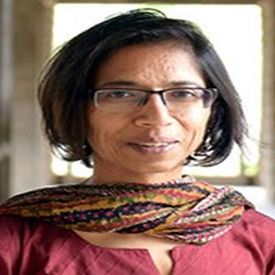The distributional consequences of political reservations
This article identifies and attempts to fill in the gaps in understanding the effects of reservations for Scheduled Castes (SCs) in Panchayats. Using data from a state-wide census, multiple administra...
-
 Chinmaya Kumar
Chinmaya Kumar  M.R. Sharan
M.R. Sharan  28 November, 2023
28 November, 2023
- Articles
Caste-based differences in self-help groups: Evidence from a rural livelihood programme
The National Rural Livelihood Mission aims to increase income and improve wellbeing for rural households. Using survey data from nine states in India, this article analyses the existence of caste-base...
-
 Chandan Jain
Chandan Jain  Krishna Kejriwal
Krishna Kejriwal  Ritwik Sarkar
Ritwik Sarkar  Pooja Sengupta
Pooja Sengupta  05 August, 2022
05 August, 2022
- Articles
India’s Women’s Reservation Act: A big win for governance and beyond
Amidst debates about the recently passed women's reservation act and whether it will reduce gender disparities on the ground, Wattal and Gopalan summarise evidence from a number of randomised evaluati...
-
 Akshara Gopalan
Akshara Gopalan  Urvashi Wattal
Urvashi Wattal  15 December, 2023
15 December, 2023
- Perspectives
Creating safe public spaces for women and alcohol consumption in bars
Bars provide on-premise alcohol consumption and serve as social drinking spaces. Kerala, in 2014, shut down all bars serving hard liquor in the state. This article examines the policy change and wheth...
-
 Saloni Khurana
Saloni Khurana  Kanika Mahajan
Kanika Mahajan  25 November, 2019
25 November, 2019
- Articles
Fifteen years of gender budgeting in India: A Retrospective
In this year’s Union Budget, Finance Minister Nirmala Sitharaman announced that she will constitute a committee to evaluate 15 years of gender budgeting. It entails looking at the budget through the...
-
 Ashok Lahiri
Ashok Lahiri  29 October, 2019
29 October, 2019
- Videos
Coping with a policy shock in rural South India: Social networks as a determinant of trust
Trust and participation in social networks are inherently interrelated. This article identifies the determinants of trust in rural South India, where a mechanism of coping with shocks through transact...
-
 Anne Hilger
Anne Hilger  Christophe Jalil Nordman
Christophe Jalil Nordman  21 October, 2019
21 October, 2019
- Articles
Closing gender gaps in India: Does increasing women’s access to finance help?
Gender gaps in women’s economic opportunities – in the labour market and in entrepreneurship – have remained high in India. This article analyses the macroeconomic impact of closing gender gaps ...
-
 Purva Khera
Purva Khera  16 August, 2019
16 August, 2019
- Articles
Inequality of opportunity among Indian women
Inequality of opportunity (IOp) in any society is that part of overall inequality which arises from factors beyond an individual’s control such as parental education, caste, gender, religion etc. Th...
-
 Akanksha Choudhary
Akanksha Choudhary  Gowtham Muthukkumaran
Gowtham Muthukkumaran  Ashish Singh
Ashish Singh  05 August, 2019
05 August, 2019
- Articles
Prevalence and evolution of dowry in India
Dowry payments are an important part of household finances in India, typically exceeding a year of earnings. This article analyses data from an all-India sample of over 70,000 marriages to document fa...
-
 Gaurav Chiplunkar
Gaurav Chiplunkar  Jeffrey Weaver
Jeffrey Weaver  24 June, 2019
24 June, 2019
- Articles
Traditional hierarchies and affirmative action in a globalising economy: Evidence from India
India has had a long-standing policy of affirmative action to address deep-rooted caste inequities and discrimination. This article compares successive age cohorts of three broad social groups – Sch...
-
 Ashwini Deshpande
Ashwini Deshpande  Rajesh Ramachandran
Rajesh Ramachandran  21 June, 2019
21 June, 2019
- Articles
Women’s work and fertility: Evidence from 200 years, 103 countries
The declining rates of female labour force participation in developing countries in the last two decades have led researchers to focus on the role of fertility in women’s labour supply decisions. Us...
-
 Daniel Aaronson
Daniel Aaronson  Rajeev Dehejia
Rajeev Dehejia  Andrew Jordan
Andrew Jordan  Cristian Pop-Eleches
Cristian Pop-Eleches  Cyrus Samii
Cyrus Samii  Karl Schulze
Karl Schulze  03 June, 2019
03 June, 2019
- Articles
Where are the Indian female politicians?
When women win elections, does it inspire other women to run for candidacy or does it convince men to close ranks before the next election?
-
 Lakshmi Iyer
Lakshmi Iyer  24 May, 2019
24 May, 2019
- Podcasts
The road not taken: Gender gaps along paths to political power
Research and policy efforts towards greater female political participation have largely focused on women’s voting behaviour, and their representation as elected public officials. However, there are ...
-
 Lakshmi Iyer
Lakshmi Iyer  Anandi Mani
Anandi Mani  21 May, 2019
21 May, 2019
- Articles
The 10% quota: Is caste no longer an indicator of backwardness?
The Constitution (124th Amendment) Bill 2019 seeks to provide for the advancement of “economically weaker sections”, through 10% reservation in government jobs and higher educational institutions ...
-
 Ashwini Deshpande
Ashwini Deshpande  Rajesh Ramachandran
Rajesh Ramachandran  17 May, 2019
17 May, 2019
- Articles
A family affair: Family members’ role in female employment decisions in India
A factor behind low female labour force participation in India is family members’ objection to women working. Based on an experiment in Karnataka, this article assesses whether employers can use lig...
-
 Joshua Dean
Joshua Dean  Seema Jayachandran
Seema Jayachandran  13 May, 2019
13 May, 2019
- Articles
Twitter feed
Tweets by Ideas4IndiaMost Popular Social Identity Posts
A division of labourers: Caste identity and efficiency in India
Castes in India are closely associated with certain occupations and determine the jobs done by millions. This study uses a new dataset to show that a large proportion of workers still work in their ca...
 Guilhem Cassan
Guilhem Cassan  Daniel Keniston
Daniel Keniston  Tatjana Kleineberg
Tatjana Kleineberg  18 November, 2022
18 November, 2022
- Articles
Sex ratios and religion in India and South Asia
In South Asia, low child sex ratios are increasingly an isolated Indian phenomenon. Within India, child sex ratios are ‘normal’ among Christians and Muslims but much lower among Hindus, Sikhs, and...
 Swati Narayan
Swati Narayan  03 April, 2019
03 April, 2019
- Articles
Hindu-Muslim fertility differentials in India: An update
Building on past research, Saswata Ghosh and Pallabi Das estimate the state- and district-level fertility differentials between Hindus and Muslims using data from the latest round of the NFHS. They sh...
 Pallabi Das
Pallabi Das  Saswata Ghosh
Saswata Ghosh  18 April, 2023
18 April, 2023
- Articles





 30 March, 2023
30 March, 2023






